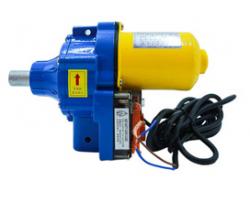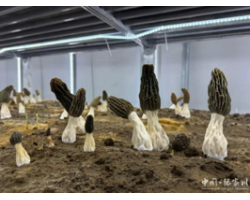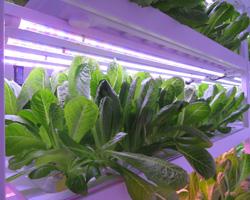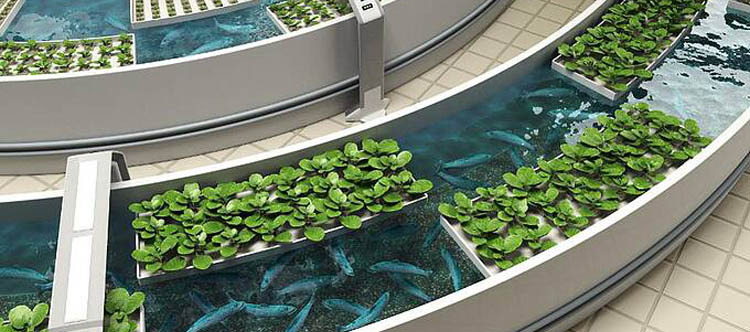Vertical farming with hydroponics
Vertical farming with hydroponics

07-07-2020 15:10 | Medium

From: www.hortibiz.com
What is a hydroponic system?
Hydroponics refers to the soilless techniques used to grow plants. There are a number of varieties of hydroponic systems, including aquaponics where live fish are used to provide fertiliser for the plants, traditional hydroponics which involves adding chemical solutions of the required nutrients, and aeroponics which uses a nutrient infused mist. Hydroponic systems can be grown in a greenhouse using natural light, or more commonly in a vertical system using LED lights, to save space.
Aquaponic system. Source: https://www.forbes.com/sites/ariellasimke/2020/04/26/aquaponics-presents-a-new-way-to-grow-sustainable-fish-and-veggies/#5acecd30e5f0
Aerofarms aeroponic system uses a nutrient infused mist. Source: https://aerofarms.com/technology/
Advantages of hydroponics
1. No soil
The earth has a finite coverage of arable land on which crops can be grown. Climate change and destructive farming practices cause loss of this soil. Soil erosion is one of the greatest threats to food security. As a result there is a growing demand for alternative, innovative approaches to provide food for the growing population. Hydroponics is one of these, providing a soilless system that can be used anywhere, particularly suited to cities.
2. Transport
As previously mentioned, hydroponic systems offer the advantage of the ability to be grow anywhere, even in the middle of a soilless city. As a result, fresh produce can be made available locally, sold in restaurants and farmers markets with minimal transport. This helps minimise greenhouse gas emissions as well as minimise nutrient loss and damage of produce, as leafy greens are quick to lose their nutritional content once harvested. Better yet, many hydroponic farms allow transport of the live produce to the market, providing the freshest possible option.
3. Reduced water usage
Hydroponic systems can use up to 10 times less water compared to traditional soil-based cultivation due to the recirculation of the water used. This offers a huge advantage as water shortage is of great concern, with field-based agriculture being one of the greatest consumers of freshwater sources - up to 80% of ground and surface waters in the U.S. Therefore, hydroponics offers a sustainable option for crop cultivation, with the growing population causing an increasing demand for food and water.
4. Controlled environment
Growing indoors allows better control of temperature, light, air composition and pests. As a result, crop growth rates, quality and yield can be maximised and can also be grown year-round. Therefore, these indoor farms can play an important role in filling the market gap, providing fresh produce in all seasons.
5. Less space
Indoor hydroponic farms are typically grown vertically, with LED lights for each layer of crops, this allows maximum usage of small spaces making it a viable option for growing crops in the city homes, in a spare room or basement. Moreover, in hydroponic systems plant roots don’t spread out as much in the search for nutrients like when grown in soil, as the roots are suspended directly in nutrient-rich solution. As a result, it is possible to grow crops much closer together, saving space.
6. Less need for herbicides and pesticides
Due to the controlled, soilless environment, pests and disease are minimised. As a result there is little need for use of chemical herbicides and pesticides which is a big bonus for health and food safety, with often no need to even wash the harvested crops.
Disadvantages and challenges of hydroponics
1. Organics debate
It has been subject to debate whether hydroponic systems should be permitted organic certification. Standard hydroponics typically uses a chemical nutrient solution, which are often not organically sourced. Moreover, it is controversial whether the absence of the soil microbiome may effect the food quality, with unknown impacts on the human microbiome, as increasing evidence suggests that the microbes we obtain from food may be an important contribution to our health.
2. limited crop variety
Due to the high light demands of fruiting plants, often requiring a wider light spectrum with a longer growth period, hydroponic technology is currently mostly limited to leafy greens due to costs. Therefore, hydroponics can in no way be seen as a complete replacement for traditional farming methods. Despite this, technological advancements are constantly improving hydroponic growth, possibly making it a viable option for a wider range of crops in the future.
3. Technical knowledge and difficulties
Understanding of the technical set-up of the hydroponics system and plant growth requirements is essential for preventing system failures. Leakages can occur and different crop types may require vastly different nutrient, temperature and lighting conditions. In addition, the close proximity of water and electrics poses risk and careful, regular monitoring of the system is required.
4. initial expenses
Although setting up a hydroponic system can be done on a budget with minimal costs, on a commercial scale, the specialist equipment required can be expensive. After the initial set up costs will be limited mainly to electricity and nutrient costs, the increased plant growth rates and yield often outweigh these added costs.
Concluding remarks
Despite the number of challenges and limitations associated with vertical farming with hydroponic systems, it still offers great potential to contribute to a more sustainable future of farming. It is important to emphasise that vertical farming and hydroponics is in no way a viable replacement for tradition farming practices but an alternative option, particularly suited to cities to help support the demand for fresh, locally-sourced healthy greens, with the growing population. Technological advancements are expected to further improve costs and efficiency of plant growth in hydroponic systems, giving it high hopes for the future.
Source: Medium
Photo: AeroFarm’s vertical farming facility source: https://time.com/collection/best-inventions-2019/5733085/aerofarms/




